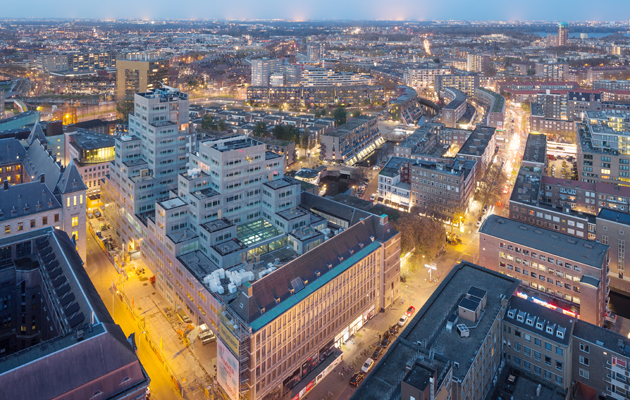|
|
||
|
A two-day conference in Rotterdam featuring Rem Koolhaas revealed the European car industry to be confident in its future, but cautious about veering too far outside its comfort zone, says Peter Smisek Traditional carmakers are facing uncertain times, with stagnating demand, concerns about their environmental impact, suspicion over tampering with emissions tests and, crucially, a cadre of self-appointed disruptors from Silicon Valley reminding us that cars will be soon be self-driving, super-connected, super-safe and definitely no longer manufactured by the old guard. This was perhaps why German car maker BMW put together an ensemble cast of its European leadership, supported by architects, city officials, an academic, and a developer for a two-day seminar in Rotterdam, the Netherlands’ second city. The location was important for two reasons. First, out of all EU countries, the Netherlands has the highest electric vehicle market penetration (last year, 6.65 per cent of cars sold were either electric or plug-in hybrids, though this number still pales in comparison to Norway’s impressive rate of 22.3 per cent). Second, BMW had recently agreed on a micro car-sharing scheme with the architects and developer of Rotterdam’s latest architectural wonder, OMA’s pixelated Timmerhuis. The event was loosely organised into a series of themed presentations, with each participant eager to present a more nuanced version of the future. The star of the first evening was undoubtedly Rem Koolhaas, who commented on the relative ineptitude of architects in car design and his reading of cars as a liberators and social levellers. He argued that this critical component has been abandoned and compared the car to the city, which too was once a platform for transgression and adventure, and is similarly being privatised and scrubbed-up by relentless, corporate interests. On the whole, he pleaded for a more level-headed approach, in which technological advances, such as autonomous driving and connectivity become means to rather than the ends of innovation. On the whole, his speech called for allowing the car to be “a privileged form of interacting with the world”. The second speaker of the evening, the vice president of design for BMW Europe Adrian van Hooydonk emphasised the traditional carmakers’ strength: such as the focus on user experience and the pleasure of driving, which he argued was absent in the standard Silicon Valley rhetoric. In this, he and Koolhaas agreed, and the architect went as far as to quote the Frankfurter Allgemeine journalist Niklas Maak, who likened Google’s car to a “depressed koala bear”. Jibes at the competition aside, it probably won’t be business as usual. Van Hooydonk admitted that cars would probably soon be able to do all the “boring bits” themselves, such as finding a parking spot or moving through a traffic jam, and that inevitably, they would be powered by batteries or exist as plug-in hybrids. He briefly mentioned motorcycles, which the company sees primarily as a “mode of leisure” in contrast to their core business – the “mode of transport” – but this was the only time when vehicles other than cars were mentioned, despite the designer citing the question of ownership versus rental and fun as one of the biggest challenges facing the industry. On the second day we were told that private cars are used about 4 per cent of the time, while car-sharing schemes achieve between 14 and 20 per cent usage, which means it makes sense for city-dwellers make use of the latter. What remained unsaid was that such car share schemes might have an effect on the traditional car market – the number of car-owners might shrink as sharing becomes the norm. Other speakers highlighted the role of the government in providing the right incentives and infrastructure for car-sharing schemes and personal electric vehicles. Unsurprisingly, densely populated western European nations and California lead the pack in providing the necessary infrastructure for the latter: the municipality of Rotterdam, which has around 600,000 inhabitants, has about 1,400 electrical charging points, and the Dutch were frequently held up as a best example, of a municipality that actively encourages cleaner vehicles. A particular point of discussion was the partnership between BMW, the municipality and the developer of Timmerhuis, which provides the mixed-use building with four, fully electric BMW i3s for the inhabitants and employees to share. Even though the building’s architect Reinier de Graaf admitted that this move was an “afterthought”, it is an interesting precedent for relatively easy retrofitting of existing parking facilities with car-sharing schemes. However, if the seminar sketched a not-too-depressing future for traditional carmakers, which, it would seem, can easily supply the market with more efficient, electric vehicles, as well as operate and maintain these schemes, it failed to mentioned alternative forms of individual transport such as bicycles, or mass transit. Even a voice from the fully automated car crowd would have been welcome. Furthermore, the solutions proposed seemed to be most appropriate for Europe’s slowly growing, genteel capitals rather than the teeming African or Asian metropoles. The future it painted was one that was close, and much too comfortable and comforting – all right for the global north, but certainly not up to the task where creative thinking is needed more than ever. Read Rem Koolhaas’s views on cars and more about OMA’s Timmerhuis in our next issue, out in early January |
Words Peter Smisek |
|
|
||

















